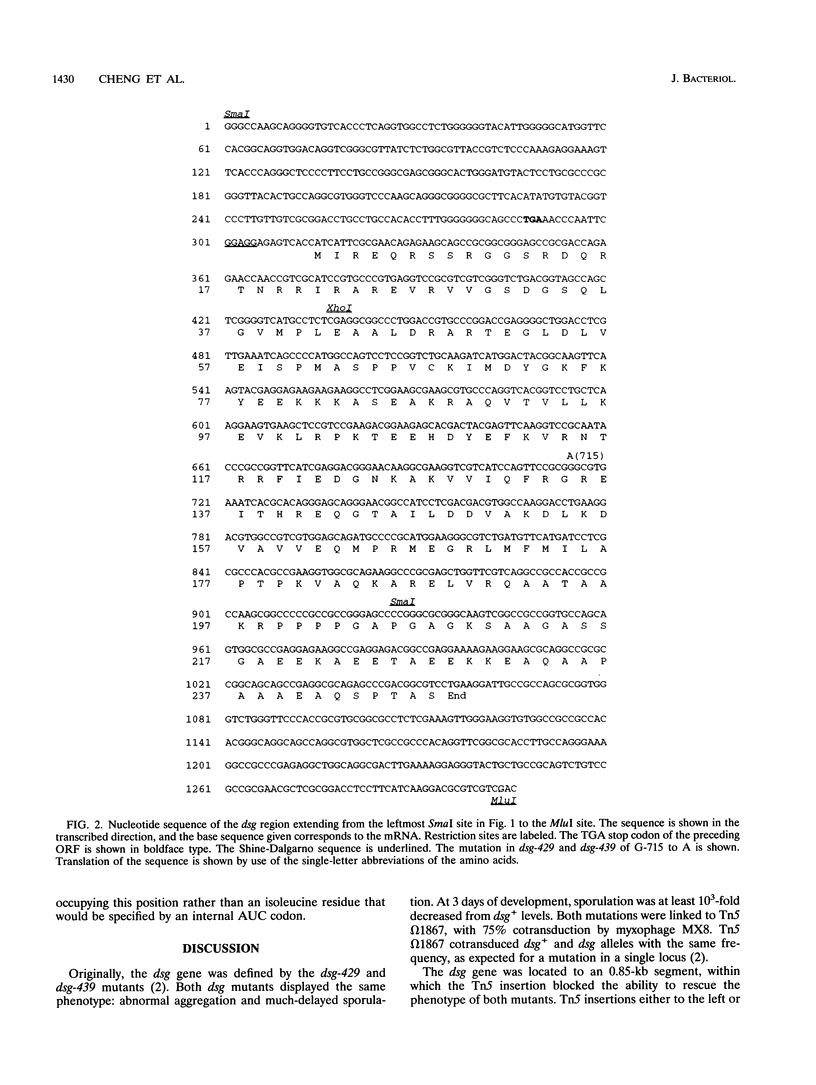Abstract
The dsg mutants of Myxococcus xanthus are defective in fruiting body development and sporulation, yet they grow normally. The deduced amino acid sequence of the dsg gene product is 50 and 51% identical to the amino acid sequence of translation initiation factor IF3 of both Escherichia coli and Bacillus stearothermophilus, respectively. However, the Dsg protein has a carboxy-terminal extension of 66 amino acids, which are absent from its E. coli and B. stearothermophilus homologs. The Shine-Dalgarno sequence GGAGG and 5 bases further upstream are identical in M. xanthus and several enteric bacteria, despite the wide phylogenetic gap between these species. The infC gene, which encodes IF3 in enteric bacteria, starts with the atypical translation initiation codon AUU, which is known to be important for regulating the cellular level of IF3 in E. coli. Translation of the Dsg protein overexpressed from the M. xanthus dsg gene in E. coli cells initiates at an AUC codon, an atypical initiation codon in the AUU class. The dsg mutants DK429 and DK439 carry the same missense mutation that changes Gly-134 to Glu in a region of amino acid identity.
Full text
PDF






Images in this article
Selected References
These references are in PubMed. This may not be the complete list of references from this article.
- Bibb M. J., Findlay P. R., Johnson M. W. The relationship between base composition and codon usage in bacterial genes and its use for the simple and reliable identification of protein-coding sequences. Gene. 1984 Oct;30(1-3):157–166. doi: 10.1016/0378-1119(84)90116-1. [DOI] [PubMed] [Google Scholar]
- Cheng Y., Kaiser D. dsg, a gene required for Myxococcus development, is necessary for cell viability. J Bacteriol. 1989 Jul;171(7):3727–3731. doi: 10.1128/jb.171.7.3727-3731.1989. [DOI] [PMC free article] [PubMed] [Google Scholar]
- Cheng Y., Kaiser D. dsg, a gene required for cell-cell interaction early in Myxococcus development. J Bacteriol. 1989 Jul;171(7):3719–3726. doi: 10.1128/jb.171.7.3719-3726.1989. [DOI] [PMC free article] [PubMed] [Google Scholar]
- Gold L. Posttranscriptional regulatory mechanisms in Escherichia coli. Annu Rev Biochem. 1988;57:199–233. doi: 10.1146/annurev.bi.57.070188.001215. [DOI] [PubMed] [Google Scholar]
- Hagen T. J., Shimkets L. J. Nucleotide sequence and transcriptional products of the csg locus of Myxococcus xanthus. J Bacteriol. 1990 Jan;172(1):15–23. doi: 10.1128/jb.172.1.15-23.1990. [DOI] [PMC free article] [PubMed] [Google Scholar]
- Hodgkin J., Kaiser D. Cell-to-cell stimulation of movement in nonmotile mutants of Myxococcus. Proc Natl Acad Sci U S A. 1977 Jul;74(7):2938–2942. doi: 10.1073/pnas.74.7.2938. [DOI] [PMC free article] [PubMed] [Google Scholar]
- Inouye M., Inouye S., Zusman D. R. Gene expression during development of Myxococcus xanthus: pattern of protein synthesis. Dev Biol. 1979 Feb;68(2):579–591. doi: 10.1016/0012-1606(79)90228-8. [DOI] [PubMed] [Google Scholar]
- Kalman L. V., Cheng Y. L., Kaiser D. The Myxococcus xanthus dsg gene product performs functions of translation initiation factor IF3 in vivo. J Bacteriol. 1994 Mar;176(5):1434–1442. doi: 10.1128/jb.176.5.1434-1442.1994. [DOI] [PMC free article] [PubMed] [Google Scholar]
- Liveris D., Schwartz J. J., Geertman R., Schwartz I. Molecular cloning and sequencing of infC, the gene encoding translation initiation factor IF3, from four enterobacterial species. FEMS Microbiol Lett. 1993 Sep 1;112(2):211–216. doi: 10.1111/j.1574-6968.1993.tb06450.x. [DOI] [PubMed] [Google Scholar]
- Manoil C., Kaiser D. Guanosine pentaphosphate and guanosine tetraphosphate accumulation and induction of Myxococcus xanthus fruiting body development. J Bacteriol. 1980 Jan;141(1):305–315. doi: 10.1128/jb.141.1.305-315.1980. [DOI] [PMC free article] [PubMed] [Google Scholar]
- Shimkets L. J. Social and developmental biology of the myxobacteria. Microbiol Rev. 1990 Dec;54(4):473–501. doi: 10.1128/mr.54.4.473-501.1990. [DOI] [PMC free article] [PubMed] [Google Scholar]
- Stephens K., Hartzell P., Kaiser D. Gliding motility in Myxococcus xanthus: mgl locus, RNA, and predicted protein products. J Bacteriol. 1989 Feb;171(2):819–830. doi: 10.1128/jb.171.2.819-830.1989. [DOI] [PMC free article] [PubMed] [Google Scholar]



